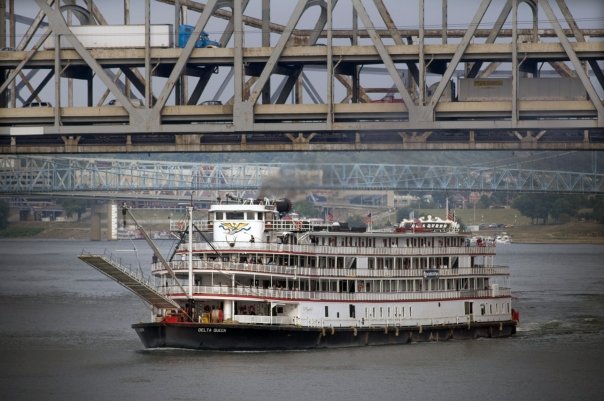The Brent Spence Replacement/Rehabilitation Project – the Cincinnati region’s largest public works project in a generation – has received more media attention in the past three months than in the nine years since project planning began in 2002. But unfortunately much of the recent conversation has been politicized, with dozens of leaders and media outlets errantly stating that the existing Brent Spence Bridge will be demolished after a new bridge is built.
At an April 20, 2009 press conference, OKI announced that the Kentucky Transportation Cabinet and the Ohio Department of Transportation had agreed on a plan that would see a new bridge built for I-75 immediately west of the Brent Spence Bridge and that the existing bridge would be rehabilitated and carry I-71. This plan was endorsed by politicians such as Kentucky Senator Jim Bunning, who remarked at the conference that “Conceptually, what they’ve pointed out to me is a very workable plan and it will be something that we all can be proud of.”
Although the local media did report on this “hybrid” plan, it was not covered repeatedly, and so failed to be absorbed by the public. When a great media wave did appear this past summer, outlets repeatedly reported that the Brent Spence Bridge would be “replaced”. Another media surge appeared in September, in anticipation of the September 22 visit by President Barack Obama. Again, it was repeatedly reported by the Cincinnati Enquirer and various television and radio stations that the Brent Spence Bridge will be replaced.
The incredible amount of confusion surrounding the project appears to have been caused by a mix of ghost writing by highway lobbyists, the unfamiliarity of the local media with how Interstate Highway projects are funded and the lingering power of postwar pro-highway propaganda.
On a half-dozen occasions this month, various Cincinnati Enquirer reporters wrote that the bridge would be replaced, in addition to letters to the editor that repeated this myth. On September 14, Enquirer reporter Amanda Van Benshoten reported that the Brent Spence Bridge would be replaced and that it “would remain open” – all in the same article.
Functionally Obsolete vs. Obsolete
The local media and politicians who have associated themselves with this project have made liberal use of the term Functionally Obsolete, engineering jargon that most often describes a bridge with no emergency shoulders, a low overhead clearance, narrow lanes, or ramps with tight curves. The power of this phrase was even invoked by President Obama in his September 22 speech:
“Behind us stands the Brent Spence Bridge. It’s located on one of the busiest trucking routes in North America. It sees about 150,000 vehicles every single day. And it’s in such poor condition that it’s been labeled “functionally obsolete.” Think about that — functionally obsolete. That doesn’t sound good, does it?”
No, it doesn’t sound good, which is why some bureaucrat (or more likely an auto industry public relations wizard) concocted it decades ago. It insinuates structural deficiency – an official term that does denote structural problems — but which does not describe the current condition of the Brent Spence Bridge.
When it is rehabilitated after a new bridge is built, the Brent Spence will have its decks restriped with three wide lanes on each deck instead of its current four narrow lanes, and emergency breakdown lanes will be restored. Its approaches will be reconfigured and it is possible that after 2020 or so the Brent Spence will no longer be classified as Functionally Obsolete.

The Delta Queen passes under the existing Brent Spence Bridge.
The Brent Spence Bridge as Boogeyman
The Brent Spence Bridge (or more accurately, the configuration of its approaches) is the worst traffic bottleneck in the Cincinnati area, but a source of delays and a panorama of rust that would hardly pass notice in New York City or Boston. It nevertheless has been pitted as an enemy by local politicians, and the failure of the local media to do basic public document research, has allowed the bridge project to become whatever any elected official says it is.
Most believe that the Brent Spence Bridge Replacement/Rehabilitation Project, even after last month’s visit by President Obama, will not receive enough funding in the upcoming Transportation Bill to break ground until the next bill is negotiated sometime around 2017 or 2018. Look for local politicians – especially those with Tea Party affiliations – to blame this delay on government.
The project could in fact break ground in the short-term if Ohio and Kentucky cooperated to toll all area Ohio River bridges. Modest tolls could generate over $1 million per week and enable the neighboring states to sell bonds sufficient to fund this project.
But the fact that this is not happening perhaps best illustrates why Congress has hesitated to allocate money – there are no major structural problems with the Brent Spence Bridge, there are three other interstate highway bridges nearby if any problem should arise, and the project’s huge scale promises a very low rate of return on the investment.

